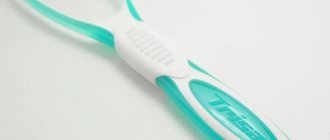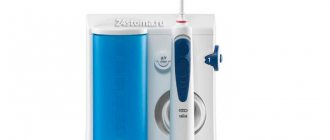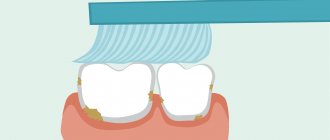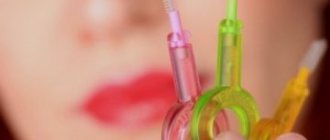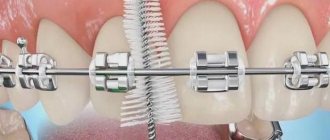The cleanliness of the apartment and bathroom is of great importance. Accordingly, objects with the help of which order is restored cannot be considered insignificant. Cleaning the toilet is not a whim, but an important part of hygiene. Therefore, here are some subtleties about how to choose toilet brushes.
When buying a brush, you should hold it in your hands, checking how comfortably it fits in your hand. If there are models on the counter with handles of different lengths, you should choose the one that is longer, so you don’t have to bend too low over the toilet. Moderate elasticity and strength of the handle characterize a high-quality model. To determine which toilet brush is best, you should take into account one more indicator - the stiffness of the bristles. Stiff bristles efficiently remove dirt from earthenware. The dismountable brush makes it easier to care for – washing, drying, disinfecting.
Appearance is of no small importance. Color, shape, finish should be combined with the design of the bathroom.
Any brush model should be periodically washed and disinfected, and then dried well. How to wash and clean a toilet brush is described below.
Washing and disinfection are usually carried out using chlorine-containing solutions, hydrogen peroxide, and soda. The stand and the brush itself are washed, rinsed, and dried thoroughly. If all conditions are met, no questions will arise about how to keep the toilet brush clean, because steamed chlorine and vinegar do an excellent job of disinfecting even heavily soiled surfaces.
The brush itself should also be regularly disinfected, even in the absence of infectious diseases. There is no need to be tormented by questions, looking for “revolutionary” ways to clean and wash a toilet brush for a toilet bowl. It is enough to use the same solutions with chlorine or buy any chlorine-containing cleaning product.
If you remember the safety rules when working with harmful substances, there will be no difficulties. When working with chlorine solutions or vinegar, precautions should be taken - wear rubber gloves, avoid getting vapors into the respiratory tract and liquid droplets on the mucous membranes.
If you are at a loss about how often to wash this device, you should remember that there are generally accepted rules for using a toilet brush. It needs to be washed at least once a month, and preferably every week. If there are cases of intestinal infection in the family, the device should be washed and disinfected every day.
Manufacturing materials
Toilet brushes can be made from the following materials:
- plastic,
- metal,
- silicone,
- ceramics,
- acrylic,
- tempered glass.
Budget models include brushes made of plastic, acrylic, and silicone. Thanks to their low price and wide selection of colors, these models always find their buyer. Many housewives choose a modern silicone toilet brush.
More expensive accessories made of ceramics, glass, and bronze are no longer just an attribute of cleaning, but a full-fledged interior detail.
Choosing the right hygiene products: review of brush models and rules for their use
Most people associate daily dental hygiene with a tube of toothpaste and a toothbrush. If the brush is chosen correctly and the teeth are straight, these items are usually enough. However, such cases are actually rare; uneven interdental spaces, dentures or braces and other deviations from the standard require more careful oral hygiene. One of the devices that provide such care are brushes for cleaning teeth. As experts note, this is truly one of the most important devices.
Color and design
Manufacturers produce these accessories in a variety of colors. When choosing the color of the brush and glass, you should focus on the design of the toilet. A good housewife's brush or brush for cleaning and washing the toilet should be in harmony with the color of the tiles, fixtures or decorative elements of the bathroom.
If the washroom is dominated by light colors and does not have contrasting trim, the bright color of the cleaning kit will look out of place. Gold and silver patterns on the brush and glass would be appropriate in the case of similar elements on tiles or wall borders.
If the toilet room is finished in marble, a toilet brush with a stand of the same color will look great in it.
The shapes of toilet brushes are also varied. Silicone models are especially different. The good plasticity of the material allows you to give fancy images to products made from it. In addition to the usual flat, round or oval shapes, manufacturers have launched the production of original models in the form of plants, household items, and weapons. In stores you can see a silicone toilet brush standing on the counter in the form of a fruit brush, a pistol brush, a flower vase brush, or anything else.
Varieties
A toilet brush is essentially an artificial fiber brush that is attached to a handle about half a meter long. It is usually sold complete with a glass stand.
Today there are many varieties of such products on the market.
If we talk about the classification of such intimate devices, they differ in color, materials of manufacture and method of storage. Let's look at each indicator in detail.
Material
Its quality and strength depend on what material was used to make the brush. A similar parameter is reflected in the cost of the brush. Today you can find products from:
- plastics. There are two types: completely plastic and having a metal rod with a plastic stand. Typically, such brushes are placed on the floor in a special holding device, but you can also find devices without stands. The products are quite cheap, but their strength leaves much to be desired;
- glass Such structures are most often fixed on the wall. The floor-standing version is equipped with metal legs or a stand;
- silicone. This species appeared on the market relatively recently. The advantage of the material is that it does not absorb moisture and does not provoke the growth of pathogenic microflora. Such an accessory, if stored properly, can last for a long time;
- acrylic Made from fairly durable material. Can be found in a variety of colors. In addition, there are transparent specimens that are filled with gel. Careful care is recommended for such products;
- ceramics. This is usually an expensive custom-made product. It is distinguished by its high cost and extraordinary fragility;
- metal (brass, stainless steel). Fits perfectly into a modern interior. This product is easy to use and maintain.
Brushes have long ceased to be just a device for maintaining frequency
It is necessary to understand that a toilet brush with a plastic or acrylic stand with filler looks out of place in classic interiors, just like a ceramic product in a modern setting.
The more reliable the material, the longer the brush can last. However, this will affect the cost. For example, metal brushes can last much longer than plastic products, but they also cost accordingly.
By storage method
According to the method of placement, brushes are divided into:
- floor. Considered a classic type. It is sometimes called a glass brush, since the toilet brush is placed in a special stand that looks like a glass. It is installed directly on the floor. Despite the popularity of this type, it is considered the least hygienic solution. The container where it is stored has dirty, damp conditions, which is a favorable environment for the growth of pathogenic microflora;
- wall. This type of brush is not too different from a floor brush. Only the stand in this modification is not located on the floor, but is mounted on the wall. The disadvantages of such a brush are the same as those of a floor brush;
- suspension. This storage method is optimal. With this placement option, the brush is hung on a special hook, and the liquid that drains will fall into a glass placed under the brush. This makes it possible to ventilate the device, which does not allow harmful microorganisms to multiply;
- multifunctional. Outwardly it looks like a high stand on which other accessories can be additionally placed, for example, containers with cleaning products.
There can be a great variety of options for placing such a prosaic item as a brush.
How to use a toilet brush correctly
In order for the use of a toilet brush to give the desired effect, you must follow some rules:
- The brush should be taken by the upper part of the handle;
- To better clean the surface, you need to apply a cleaning agent to the bristles;
- The toilet should be cleaned with calm, smooth movements, avoiding splashing;
- At the end of cleaning, the brush should be rinsed, shaken slightly and carefully placed in a glass. These procedures must be carried out very carefully to avoid splashes on the walls and floor of the toilet.
These were the basic principles on how to properly use a toilet brush. By following these rules, you can keep the toilet clean and tidy.
Accessory requirements
When you are thinking about buying a brush, you need to think about how well it will meet your requirements and certain criteria. There is a small list of characteristics that any toilet brush must meet.
- The cleaning element must be made of a synthetic material with sufficient rigidity. With its help, it will be much easier to remove dirt.
- The handle is preferably smooth in texture, long enough, and made of durable material. It should be comfortable to hold, but at the same time strong bends are not allowed.
- Preference should be given to collapsible models, since cleaning them in this case will be much easier.
Terms of use
Photo of a designer brush
For some this may seem funny. In principle, you have every right to laugh at the instructions for a toilet accessory. However, you should have a clear understanding of how to use a brush. This will be useful to you yourself, and will also allow you to correctly interpret to your child what this thing is, what it is for, and how to use it correctly.
- The first thing you need to do is grab the handle comfortably and with a firm grip. Do not hold the toilet brush too close to the cleaning head. Actually, almost every model has a specific section of the handle intended for holding by hand.
- Using progressive, gentle movements, begin to remove dirt. You should first dip the brush in water and wet it, after which removal will be easier. In order to simultaneously get rid of excess odors and disinfect the toilet, add a little detergent and cleaner to the toilet.
- Drain the toilet using the flush cistern, while placing a brush under the pressure of the water. This will remove any remaining dirt from it and clean it.
- After rinsing the toilet brush, shake it off a little, after which you can safely put it back in its rightful place.
There are a couple more very useful tips that you should definitely follow and that it is extremely important to teach your children
- When you start cleaning after your business using a toilet brush, do not make any sudden movements. This may result in splashes that fly towards you, onto your clothing, or even onto your skin. We think you shouldn’t imagine what sensations you will experience. Don't take risks, so work the tool smoothly.
- Shake the accessory while it is still inside the toilet by hitting the walls directly next to the water in the plumbing. Many people begin to shake off, hitting the end of the handle on the toilet seat. This causes splashes to fly in different directions, onto the toilet seat itself, onto the toilet lid, onto the wallpaper, and so on.
Storage and care
Interestingly, many people prefer glass and wall-mounted models. However, from the point of view of safety and hygiene, this is the most wrong decision.
But the recommended option is suspended. But even here it is advisable to comply with certain conditions:
- Your toilet brush should not be in contact with the floor;
- The accessory should not come into contact with the wall;
- Be sure to place a container underneath it that is wide enough to allow all the water to drain into it.
Now regarding care. Please note that the toilet brush will have to be washed periodically. The more often this happens, the safer it will be to use. Essentially, there are two proven, effective cleaning methods.
- Dip the cleaning head into any liquid intended for disinfection, thereby getting rid of all kinds of bacteria and infections.
- Wet the toilet brush using white vinegar. Just be careful not to get the liquid on your skin, especially your eyes.
When the disinfection procedure is completed, lower the cleaning head into the toilet, press the water release button, thereby washing the instrument. After this, you can safely put the accessory in place.
It is recommended to hold such events at least once a month. But this is provided that you or your household do not have an intestinal infection. If there are any, then the brush should be cleaned weekly.
As you can see, a brush is far from the simplest accessory for toilets. It has its own characteristics, its own recommendations for use and care.
Despite a number of recommendations for use and selection, you should purchase not only on the basis of safety, so to speak. The modern range of brushes is so huge that all your personal wishes can be combined in one model, and at the same time the tool will fully comply with even the most stringent requirements for hygiene and reliability.
Storage and care
Some housewives wonder how often they need to change their toilet brush. Toilet brushes are items that require regular replacement. Even with constant use of disinfectants, they should be replaced with new ones every 3 months. During operation, you must adhere to the following recommendations:
- after each use, the brush is rinsed in water with a disinfectant;
- every week the brush should be soaked in disinfectant solutions (with chlorine, potassium permanganate, hydrogen peroxide, boric acid), and the liquid for the toilet brush should be prepared fresh each time;
- After visiting the toilet by a person with a gastrointestinal disorder, the brush is cleaned every day.
These are the usual recommendations for cleaning a toilet brush. During disinfection, we must not forget about safety precautions. You should wear gloves when working with disinfecting solutions, avoiding getting them into your mouth, eyes, or mucous membranes.
Main functionality of kvacha
In some European countries and America, they do not know that such a toilet cleaner exists. This is explained by the fact that some regions have a special flushing system. They release water in a large stream, which removes all traces.
In Russia there are cisterns, so the water comes in small doses, which does not allow all traces to be completely washed away, and it is necessary to use a wall-mounted or floor-mounted toilet brush to maintain cleanliness.
This item also helps prevent the formation of limescale. It rids the surface of various microbes, which in large quantities can be dangerous to human life.
Household chemicals
Pour into a glass where there is a brush “Domestos” or “Silit”, “Belizna” which will also help to clean the brush well. Wiggle it around, breaking up solid deposits well.
Advice. For this purpose, take Domestos in a dark bottle. Cleans everything completely, even heavy-duty stains.
Pour in new detergent and soak the brush for two or three hours. Be sure to wash it later with clean running water. During soaking, it is better to take this brush to the balcony or other space so as not to breathe in harmful fumes.
When working with household chemicals, do not forget about rubber gloves and safety glasses.
To improve the ability of water to drain from the brush, if you are not using a mounted brush, clamp it between the toilet lid and leave it in this position for the water to drain.
Sunlight is the best disinfectant.
The sun's rays kill known bacteria and viruses and have a disastrous effect on the testicles of worms, which are not susceptible to the action of antiseptic substances due to their dense outer shell. Place it in the open rays of the sun for 10 - 15 minutes
What to look for when choosing
Manufacturers produce brushes for brushing teeth in different versions, so the question arises - how to choose the right one and what to pay attention to. When purchasing, it is extremely important to consider the following product characteristics:
- length of the device: a shorter one, marked S, is suitable for children, and a brush marked XL is preferable for adults; In addition, there are intermediate options,
- lint length: this parameter determines how good the cleaning will be; if there are large gaps between the teeth, you should choose a product with long bristles (at least three millimeters), with densely spaced units of the dentition you need bristles about 1-3 mm long,
- stiffness of the bristles: selected depending on the sensitivity of the gums and enamel layer - if it is high, bleeding gums are observed, the choice should be made in favor of soft bristles; in other cases, it is enough to purchase a product with medium-hard bristles,
- material: the main rod to which the bristles are attached can be metal or plastic; If the dentition is in perfect order, dentists recommend purchasing products with a metal rod; if you have high sensitivity of the enamel layer and dental problems, it is better to opt for plastic models.
It is important to know! In general, when choosing a product, you should focus on the individual characteristics of the anatomy of the jaws, the presence or absence of bridges, implants, braces and other nuances. Before purchasing, it is advisable to talk to your dentist to get professional recommendations. Remember that brushes are strictly prohibited when any prosthetic structures (crowns, bridges, etc.) and dental implants are installed in the mouth!
Review of the most popular products
Which brushes are best for teeth? Below is a brief overview of the most popular brands, created based on reviews from online users.
LACALUT
LACALUT products are distinguished by the material they are made of - this is a special mass used for the production of surgical instruments. Great for cleaning teeth with braces. The protective cap can be used to extend the holder. Cost – 230-420 rubles.
CURAPROX
The manufacturer has tried to produce models for any purpose: simple teeth cleaning, with braces. The line includes products of different configurations and sizes. Can be used both for self-care of the oral cavity and for professional hygiene. Cost – 800-2000 rubles.
Plackers Interdental Mix
This set is perfect for a beginner – it contains products with different sized attachments. The rod is flexible and the holder is quite long. The kit includes a protective cap. Cost – 240-300 rubles.
PresiDENT
PresiDENT models are distinguished by their curved shape, comfortable holder, and compact size. They are mainly intended for people whose dentition is very dense and the spaces between the teeth are narrow. Cost – 240-480 rubles.
Oral-B
Products of this brand are also presented in a wide variety - brushes in the form of cones, cylindrical shapes, equipped with durable and convenient removable holders are available for sale. A plus is the presence of a hygienic storage container. Cost – 320-550 rubles.
Colgate
The company produces products for all occasions, having a variety of shapes and sizes of bristles and holder. High hygiene efficiency with Colgate brushes is achieved thanks to the triangular cross-section of the bristles. Cost – 350-650 rubles.
Purchasing and using a dental brush will significantly improve the quality of hygiene and improve the condition of the oral cavity. However, it is worth remembering that this product does not replace a regular toothbrush and toothpaste. Moreover, only comprehensive use of dental hygiene products will help maintain their health for many years.
What kind of fish is ruff?
The common ruff (lat. Gymnocephalus cernuus) is a species of fish from the perch family (Percidae), the type species of the genus Gymnocephalus. This is a freshwater fish that lives in reservoirs of Europe and northern Asia, near the bottom of lakes, dams, and near river banks, preferring a sandy bottom or gravel.
Interesting materials:
Where on the planet does a new day break first? Where on the license is the start date of the experience? Where is the login on the router? Where is the pressure written on the tire? Where did the first hookahs begin to be made? Where does the Thames begin and end? Where is the forest industry most developed? Where can I find a blood fruit tree in The Sims 4? Where can I find a tow truck in GTA V online? Where can I find voice messages on WhatsApp?
Advantages compared to other devices
The product has a number of advantages compared to floss, toothpicks and other oral hygiene items. Most often, users point to the following positive aspects:
- cheaper than an irrigator, with almost the same effect,
- Great for cleaning teeth with braces,
- if there are interdental spaces of different sizes, you can use different attachments of the product,
- They clean the bases of teeth well, especially the chewing group: these areas cannot be cleaned efficiently with conventional devices,
- promote visual whitening of enamel, preventing the accumulation of pigment in it,
- suitable for children.
In addition, brushes massage the gums, improving blood flow in them, thus preventing the development of many dental diseases.
Vinegar
Regular table vinegar, which can be found in every home, will help you easily wash the toilet and cleaning items in the restroom.
This method will make the brush white and remove the unpleasant odor.
To make your brush smell nice and clean, use this homemade method:
- Pour concentrated detergent into a container, add 100 g of soda and 2 tbsp. l. salt. After the small particles dissolve, add 50 ml of vinegar and pour boiling water over everything. The accessory must remain in the solution for 1 hour. Then wash it under running water over the toilet using a shower head.
- You can also use this cleaning agent: fill the brush with a solution of citric acid, and then add vinegar. Foam will begin to form, which means the product has reacted and after it has finished, you can wash the brush with warm water, removing any remaining stuck dirt.
Vinegar is the most effective remedy. After using it, your toilet brush will be as good as new.
Vinegar can also be poured into the tank to remove deposits due to bad water. The main thing is to know the correct concentration. Usually the tank has a very strong limescale deposit, so you will need to pour 1 cup of vinegar into it.
After an hour, the plaque is pulled out and the tank is rinsed.
Accommodation
If you want to leave the product on the floor, then a regular floor model is suitable, which can be moved wherever necessary if necessary. If you prefer the idea of placing a brush at a height, then a wall-mounted model is the best choice. At the same time, you can attach the brush holder to the wall using a suction cup, which means ease of removal, and using bolts for strength. If you want to hang the brush itself, and not its holder, then you will need to choose any hanging model. By the way, today you can find replacement brushes and holders in stores. They allow you not to change the entire structure, but only a part of it that has lost its appearance.
Rules for using the product
How to properly brush your teeth with brushes to get the desired effect, but at the same time, not harm your gums and enamel? During the hygiene process, you need to pay attention to the following points:
- before using a new brush, you need to treat it with an antiseptic solution: you can also boil it for 2-3 minutes if it is made of hard plastic, or treat it with a UV lamp,
- the nozzle should be changed at least once every 7-10 days,
- you need to brush your teeth with a brush without paste or powder,
- bleeding gums in the first 1-3 days after starting to use the product is a normal phenomenon that goes away on its own,
- Do not move up and down when cleaning,
- the device is not used to clean the incisors of both jaws,
- if the product does not fit well into the space between the teeth, you need to change the nozzle: choose a shorter bristles size,
- procedure duration 2 minutes,
- when inserting the rod between the teeth and during the cleaning process, you should not put additional pressure on the brush for a “better” effect: this risks damaging the enamel layer,
- You need to use the device twice a day,
- After the procedure is completed, the product is washed with water, treated with an antiseptic, and dried.
In addition, the quality of hygiene is also affected by the cost of the device - cheap models, as a rule, are made of low-grade materials that quickly become deformed and become unusable.
In what cases should this product be used?
It is recommended to use a dental brush in the following situations:
- requires more thorough oral hygiene than a toothbrush and even dental floss can provide,
- under normal conditions, the back surface of the dentition is poorly cleaned,
- pieces of food get stuck between the teeth, which cannot be removed using conventional methods (rinsing or brushing),
- a bracket system is installed on the dentition, the elements of which require better care,
- Plaque often accumulates on the enamel, and ordinary cleaning cannot cope with it.
If you find yourself with such problems, anyone can buy a brush for brushing their teeth and improve the quality of their oral hygiene.
“In addition to preventive and general recommendations for use, the products also have medical indications. For example, they must be used if braces are installed, if there are pathological changes in periodontal tissues. They are also indicated in the presence of crowding of dentition units or, on the contrary, in case of significant interdental spaces. In addition, the dentist may advise you to use a brush if you smoke, drink a lot of coffee or black tea, or often consume products with dyes - the device helps not only remove plaque from the enamel, but also prevent its staining,” says the expert, dental therapist Uspangalieva Nina Borisovna.
What types are there
There are three types of hygienic devices:
- cylindrical: have the same length of bristles throughout the base; They cope well with food stuck between teeth and help prevent periodontitis due to the high-quality removal of plaque from narrow spaces. Quite inexpensive and ubiquitous
- in the form of a cone: as you move towards the tip of the brush, the bristles become shorter, which makes it possible to penetrate deeper into interdental crevices of different sizes. They cost more than the previous option,
- curved: great for people who have braces installed, as they allow you to clean areas that are inaccessible to a regular brush (for example, under the clasps of braces, in the spaces between crowns, and so on). The cost is higher than other models.


